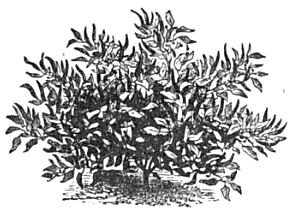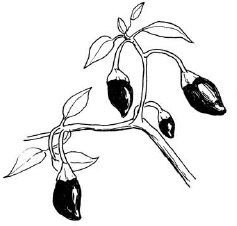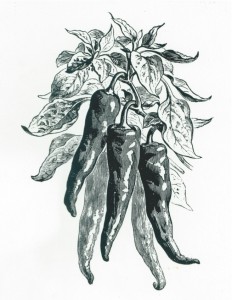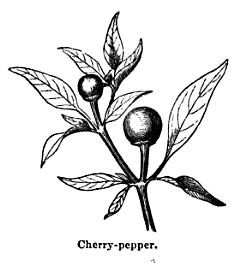Editor’s Note. This is a listing and description of the peppers of the Capsicum genus commonly grown in the United States in 1865. It is from the book The Field and Garden Vegetables of America, by Fearing Burr. Boston: J. E. Tilton & Co., 1865. Please remember that we have learned a lot about chile peppers since this was written, like, for example, that all Capsicums are perennial. This is definitely a period piece.
Capsicum. Capsicum annuum.

Of the Capsicum there are many species, both annual and perennial; some of the latter being of a shrubby or woody character, and from four to six feet in height. As they are mostly tropical, and consequently tender, none but the annual species can be successfully grown in open culture in the Middle States or New England. The Capsicum annuum, or Common Garden-pepper, is a native of India. The stalks vary in height from a foot to nearly three feet; the flowers are generally white or purple; the pods differ in a remarkable degree in size, form, color, and acridness; the seeds are yellow, nearly circular, flattened, and, like the flesh or rind of the fruit, remarkable for their intense piquancy—nearly forty-five hundred are contained in an ounce, and their vitality is retained five years.
Propagation and Cultivation. The plants are always propagated from seeds. Early in April, sow in a hot-bed, in shallow drills six inches apart, and transplant to the open ground when summer weather has commenced. The plants should be set in warm, mellow soil, in rows sixteen inches apart, and about the same distance apart in the rows; or, in ordinary seasons, the following simple method may be adopted for a small garden, and will afford an abundant supply of peppers for family use: When all danger from frost is past, and the soil is warm and settled, sow the seeds in the open ground, in drills three-fourths of an inch deep, and fourteen inches apart; and, while young, thin out the plants to ten inches apart in the rows. Cultivate in the usual manner, and the crop will be fit for use early in September.
Use. The pod, or fruit, is much used in pickles, seasonings, and made dishes; as both the pod and seeds yield a warm, acrid oil, the heat of which, being imparted to the stomach, promotes digestion, and corrects the flatulency of vegetable aliments. The larger and more common sorts are raised in great quantities, by market gardeners in the vicinity of populous towns, for the supply of pickle-warehouses.
Species and Varieties
 BELL-PEPPER. Large Bell. Bull-nose. Plant two feet and upwards in height, stocky and branching, the stem and branches often stained or clouded with purple; leaves large, on long stems, smaller, smoother, and less sharply pointed, than those of the Squash-pepper; flowers white, sometimes measuring -nearly an inch and a half in diameter. The pods, which are remarkably large, and often measure nearly four inches deep and three inches in diameter, are pendent, broadest at the stem, slightly tapering, and generally terminate in four obtuse, cone-like points. At maturity, the fruit changes to a brilliant, glossy, coral red. The Bell-pepper is early, sweet and pleasant to the taste, and much less acrid or pungent than most of the other sorts. In many places, it is preferred to the Squash-pepper for pickling, not only because of its mildness, but for its thick, fleshy, and tender rind. In England, they are pickled as follows: The pods are plucked while green, slit down on one side, and, after the seeds are taken out, immersed in salt and water for twenty-four hours; changing the water at the end of the first twelve. After soaking the full time, they are laid to drain an hour or two; put into bottles or jars; and boiled vinegar, after being allowed to cool, poured over them till they are entirely covered. The jars are then closely stopped for a few weeks, when the pods will be fit for use. In this form, they have been pronounced the best and most wholesome of all pickles.
BELL-PEPPER. Large Bell. Bull-nose. Plant two feet and upwards in height, stocky and branching, the stem and branches often stained or clouded with purple; leaves large, on long stems, smaller, smoother, and less sharply pointed, than those of the Squash-pepper; flowers white, sometimes measuring -nearly an inch and a half in diameter. The pods, which are remarkably large, and often measure nearly four inches deep and three inches in diameter, are pendent, broadest at the stem, slightly tapering, and generally terminate in four obtuse, cone-like points. At maturity, the fruit changes to a brilliant, glossy, coral red. The Bell-pepper is early, sweet and pleasant to the taste, and much less acrid or pungent than most of the other sorts. In many places, it is preferred to the Squash-pepper for pickling, not only because of its mildness, but for its thick, fleshy, and tender rind. In England, they are pickled as follows: The pods are plucked while green, slit down on one side, and, after the seeds are taken out, immersed in salt and water for twenty-four hours; changing the water at the end of the first twelve. After soaking the full time, they are laid to drain an hour or two; put into bottles or jars; and boiled vinegar, after being allowed to cool, poured over them till they are entirely covered. The jars are then closely stopped for a few weeks, when the pods will be fit for use. In this form, they have been pronounced the best and most wholesome of all pickles.
 BIRD-PEPPER. Stem fifteen to eighteen inches high; leaves very small; flowers white, about two-thirds of an inch in diameter; pods erect, sharply conical, an inch and three-quarters long, about half an inch in diameter, and of a brilliant coral-red when ripe. The variety is late. If sown in the open ground, some of the pods, if the season be favorable, will be fit for use before the plants are destroyed by frost; but few will be fully perfected unless the plants are started under glass. The Bird-pepper is one of the most piquant of all varieties, and is less valuable as a green pickle than many milder and thicker-fleshed sorts. It is cultivated in rows fourteen inches apart, and ten or twelve inches asunder in the rows. If sown in the open ground, make the rows the same distance apart, and thin the young plants to the same space in the rows.
BIRD-PEPPER. Stem fifteen to eighteen inches high; leaves very small; flowers white, about two-thirds of an inch in diameter; pods erect, sharply conical, an inch and three-quarters long, about half an inch in diameter, and of a brilliant coral-red when ripe. The variety is late. If sown in the open ground, some of the pods, if the season be favorable, will be fit for use before the plants are destroyed by frost; but few will be fully perfected unless the plants are started under glass. The Bird-pepper is one of the most piquant of all varieties, and is less valuable as a green pickle than many milder and thicker-fleshed sorts. It is cultivated in rows fourteen inches apart, and ten or twelve inches asunder in the rows. If sown in the open ground, make the rows the same distance apart, and thin the young plants to the same space in the rows.
The “Cayenne Pepper-pot” of commerce is prepared from Bird-pepper in the following manner: “Dry ripe peppers well in the sun, pack them in earthen or stone pots, mixing common flour between every layer of pods, and put all into an oven after the baking of bread, that they may be thoroughly dried; after which, they must be well cleansed from the flour, and reduced to a fine powder. To every ounce of this, add a pound of wheat-flour, and as much leaven as is sufficient for the quantity intended. After this has been properly mixed and wrought, it should be made into small cakes, and baked in the same manner as common cakes of the same size; then cut them into small parts, and bake them again, that they may be as dry and hard as biscuit, which, being powdered and sifted, is to be kept for use.”
 CAYENNE PEPPER. C. frutescens. The pods of this variety are quite small, cone-shaped, coral-red when ripe, intensely acrid, and furnish the Cayenne Pepper of commerce. Like the other species of the family, it is of tropical origin; and being a perennial, and of a shrubby character, will not succeed in open culture at the North. Both the green and ripe pods are used as pickles, and also for making Chili vinegar or pepper-sauce; which is done by simply putting a handful of the pods in a bottle, afterwards filled with the best vinegar, and stopping it closely. In a few weeks, it will be fit for use.
CAYENNE PEPPER. C. frutescens. The pods of this variety are quite small, cone-shaped, coral-red when ripe, intensely acrid, and furnish the Cayenne Pepper of commerce. Like the other species of the family, it is of tropical origin; and being a perennial, and of a shrubby character, will not succeed in open culture at the North. Both the green and ripe pods are used as pickles, and also for making Chili vinegar or pepper-sauce; which is done by simply putting a handful of the pods in a bottle, afterwards filled with the best vinegar, and stopping it closely. In a few weeks, it will be fit for use.
The process of preparing Cayenne Pepper is as follows. The pods are gathered when fully ripe. In India, they are dried in the sun; but in cooler climates they should be dried on a slow hot-plate, or in a moderately heated oven: they are then pulverized, and sifted through a fine sieve, mixed with salt, and, when dried, put into close, corked bottles, for the purpose of excluding the air. This article is subject to great adulteration, flour being often mixed with it; and, still worse, red lead, which is much of the same color, and greatly increases the weight.
A better method is to dry the pods in a slow oven, split them open, extract the seeds, and then pulverize them (the pods) to a fine powder, sifting the powder through a thin muslin sieve, and pulverizing the parts that do not pass through, and sifting again, until the whole is reduced to the finest possible state. Place the powder in air-tight glass bottles; but add no salt or other ingredient whatever.” The pods of either of the long-fruited sorts, or those of the Cherry-pepper, prepared as above, will furnish a quality of “Cayenne” Pepper greatly superior to that ordinarily sold by grocers, or even by apothecaries and druggists. The larger and milder kinds, powdered in the same manner, make a. wholesome and pleasant grade of pepper of sufficient pungency for a majority of palates.
 CHERRY-PEPPER. Capsicum cerasiforme. Stem twelve to fifteen inches high, strong and branching; leaves comparatively small, long, narrow, and sharply pointed; flowers white, three-fourths of an inch in diameter; pod, or fruit, erect, nearly globular or cherry-form, and, at maturity, of a deep, rich, glossy, scarlet color. It is remarkable for its intense piquancy; exceeding in this respect nearly all the annual varieties. It is not so early as some of the larger sorts; but in favorable seasons will perfect a sufficient portion of its crop in the open ground, both for seed and pickling. For the latter purpose, the peppers should be Cherry-pepper. plucked while still green, put into a common or wide-mouthed bottle, and vinegar added to fill the vessel. In a few weeks, they will be fit for use. When in perfection, the plants are very ornamental; the glossy, coral-red of the numerous pods presenting a fine contrast with the deep- green foliage by which they are surrounded. A variety occurs with larger, more conical, and pendent pods. The plant is also much larger, and quite distinct in its general character.
CHERRY-PEPPER. Capsicum cerasiforme. Stem twelve to fifteen inches high, strong and branching; leaves comparatively small, long, narrow, and sharply pointed; flowers white, three-fourths of an inch in diameter; pod, or fruit, erect, nearly globular or cherry-form, and, at maturity, of a deep, rich, glossy, scarlet color. It is remarkable for its intense piquancy; exceeding in this respect nearly all the annual varieties. It is not so early as some of the larger sorts; but in favorable seasons will perfect a sufficient portion of its crop in the open ground, both for seed and pickling. For the latter purpose, the peppers should be Cherry-pepper. plucked while still green, put into a common or wide-mouthed bottle, and vinegar added to fill the vessel. In a few weeks, they will be fit for use. When in perfection, the plants are very ornamental; the glossy, coral-red of the numerous pods presenting a fine contrast with the deep- green foliage by which they are surrounded. A variety occurs with larger, more conical, and pendent pods. The plant is also much larger, and quite distinct in its general character.
CHERRY-PEPPER. Yellow-fruited. This is a variety of the Red Cherry. The plants have the same general habit, require the same treatment, and perfect their fruit at the same season. There is little real difference between the sorts, with the exception of the color of the fruit; this being clear yellow. To preserve either of these varieties for use in the dry state, all that is necessary is to cut off the plants close to the roots when the fruit is ripe, and hang them, with the fruit attached, in any warm and dry situation. They will retain their piquancy for years.
CHILI PEPPER. Pods pendant, sharply conical, nearly two inches in length, half an inch in diameter, of a brilliant scarlet when ripe, and exceedingly piquant; plant about eighteen inches high; leaves numerous, of small size, and sharply pointed; flowers white, nearly three-fourths of an inch in diameter. Sow in a hot-bed in April, and transplant to the open ground in May, about fourteen inches apart in each direction. Requires a long, warm season.
![]() LONG RED PEPPER. Fruit brilliant, coral-red, generally pendulous, sometimes erect, conical, often curved towards the end, nearly four inches in length, and from an inch to an inch and a half in diameter; skin, or flesh, quite thin, and exceedingly piquant. Stalk about two feet high; foliage of medium size, blistered and wrinkled; flowers an inch in diameter, white. The variety yields abundantly, but attains its greatest perfection when started in a hot-bed. The ripe pods, dried and pulverized as directed for Cayenne Pepper, make an excellent substitute for that pepper. The plants, with ripe fruit, are very ornamental.
LONG RED PEPPER. Fruit brilliant, coral-red, generally pendulous, sometimes erect, conical, often curved towards the end, nearly four inches in length, and from an inch to an inch and a half in diameter; skin, or flesh, quite thin, and exceedingly piquant. Stalk about two feet high; foliage of medium size, blistered and wrinkled; flowers an inch in diameter, white. The variety yields abundantly, but attains its greatest perfection when started in a hot-bed. The ripe pods, dried and pulverized as directed for Cayenne Pepper, make an excellent substitute for that pepper. The plants, with ripe fruit, are very ornamental.
LONG YELLOW. Ponds pendent, long, and tapering, three to four inches in length, and about an inch in their greatest diameter. At maturity, they assume a lively, rich, glossy yellow; and the plants are then showy and ornamental. Stem two feet and upwards in height, slightly colored with purple at the intersection of the branches and insertion of the leaf-stems; leaves of medium size, smaller and paler than those of the Long Red; flowers white, nearly an inch in diameter. Like the last named, it is very piquant. It is also late; and, to obtain the variety in perfection, the seed should be started in a hot-bed in April.
PURPLE OR BLUE. Black-podded. Fruit erect, on long stems, bluntly cone-shaped, two inches and a half in length, and a half or three-fourths of an inch in diameter at the broadest part. Before maturity, the skin is green or reddish-green, clouded or stained with black or purplish-brown; but, when ripe, changes to rich, deep, indigo blue. Plant two feet or upwards in height, more erect and less branched than other varieties, and much stained with purple at the intersection of the branches and at the insertion of the leaf-stems; leaves of medium size, or small, long, and sharply pointed; leaf-stems long, deep-green; flowers white, tipped with purple, about three-fourths of an inch in diameter; flower-stems long, purple. A rare, richly colored, and beautiful pepper, but not cultivated or of much value as an esculent. For its full perfection, a long, warm season is requisite. The plants should be started in a hot-bed in March or April, and transplanted in May to the open ground, fifteen inches apart.
QUINCE PEPPER. This variety is similar to the Sweet Spanish; but the fruit is rather longer, and its season of maturity is somewhat later. Its flavor is comparatively mild and pleasant; but, like the Sweet Spanish, it is not generally thick-fleshed. At maturity, the fruit is a brilliant coral-red.
LARGE RED CHERRY-PEPPER. This is but a sub-variety of the Common Red Cherry-pepper, differing only in its larger size. It is quite late, and should be started in a hot-bed.
SQUASH-PEPPER. Tomato-shaped. Fruit compressed, more or less ribbed, about two inches and three-quarters in diameter, and two inches in depth; skin smooth and glossy, when ripe, of a brilliant coral-red; flesh thick, mild and pleasant to the taste, though possessing more piquancy than the Large Bell or Sweet Spanish. Plant about two feet high, stout and branching; leaves broad and large; flowers white, an inch and a quarter in diameter; fruit drooping, the fruit-stem short and thick. The Squash-pepper is extensively grown for the market, and is most in use in the pickle warehouses of the Eastern and Middle States. In field-culture, the plants are started in hot-beds in April, and, after the beginning of summer weather, transplanted to the open ground, fourteen to eighteen inches apart, according to the quality of the soil. The fruit is generally sold by weight; and an acre of land, in a fair state of cultivation, will yield about three tons,—a bushel of the thick-fleshed sort weighing nearly thirty-two pounds. An excellent pickle may be made by preparing the peppers in the manner directed for the Bell variety. As grown by different market-men and gardeners, there are several sub-varieties of the Squash-pepper, differing both in form and in the thickness of the flesh; the latter quality, however, being considered of the greater importance, as the thick-fleshed sorts not only yield a greater weight to the acre, but are more esteemed for the table. The Squash-pepper succeeds well when sown in the open ground in May, in drills fourteen inches apart. The plants should be ten or twelve inches apart in the rows; for, when grown too closely, they are liable to draw up, making a weakly, slender growth, and yield much less than when allowed sufficient space for their full development. Low-growing, stocky, and branching plants are the most productive.
SWEET MOUNTAIN PEPPER. This variety resembles the Large Bell, if it is not identical. The Sweet Mountain may be somewhat larger; but, aside from this, there is no perceptible difference in the varieties.
SWEET SPANISH. Fruit obtusely conical, often four inches in length, and nearly three inches in diameter,—brilliant glossy scarlet at maturity; stem strong and sturdy, two feet or more in height; leaves large, but narrower than those of the Large Bell; flowers white, and of large size, usually an inch and a half in diameter; fruit sometimes erect, but generally drooping. Though one of the largest varieties, the Sweet Spanish is also one of the earliest. The flesh is sweet, mild, and pleasant; and the variety is much esteemed by those to whom the more pungent kinds are objectionable. When prepared in the same form, it makes a pickle equally as fine as the Large Bell. The Sweet Spanish Pepper succeeds well if sown in the open ground in May. Make the rows sixteen inches apart, and thin the plants to a foot apart in the rows.
YELLOW SQUASH-PEPPER. Yellow Tomato-formed. Fruit similar in form to the Squash-pepper, but of smaller size, erect or pendulous; orange-yellow at maturity. The variety is later than the last named; much less productive; and, for pickling, is comparatively not worthy of cultivation.





